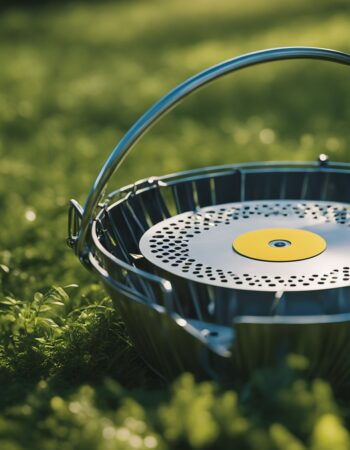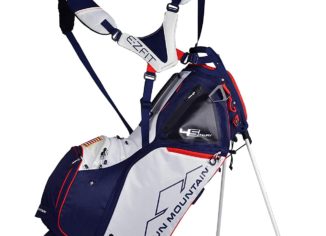Disc golf is a sport that has been growing in popularity over the years. It’s a fun and challenging game that combines the skills of golf with the excitement of throwing a frisbee. The game is played on a course with a series of baskets, and the objective is to throw the disc into each basket in as few throws as possible.
To play disc golf, you will need a set of discs. There are different types of discs that are used for different shots, much like clubs in golf. The three main types of discs are drivers, mid-range discs, and putters. Drivers are used for long shots, mid-range discs for shots that require more accuracy, and putters for short shots.
The game of disc golf is played much like traditional golf. Players take turns throwing their discs from a tee pad and aim to land the disc in the basket in as few throws as possible. The player with the lowest score at the end of the round wins. Disc golf is a great way to get outside and enjoy the outdoors while also getting some exercise.
Understanding the Basics
Disc golf is a fun and challenging sport that can be enjoyed by players of all skill levels. To get started, it is important to understand the basics of the game. This section will cover the key concepts of scoring, understanding the course, and the rules and regulations.
Scoring in Disc Golf
The goal of disc golf is to complete the course in as few throws as possible. Each hole has a designated par, which is the number of throws it should take an expert player to complete the hole. A player’s score is the total number of throws it takes them to complete the course.
The lowest score wins, and ties are broken by comparing the score of the last hole played. For example, if two players finish with the same score, the player who completed the last hole with fewer throws wins.
Understanding the Course
Disc golf courses are typically made up of 18 holes, each with a designated target or basket. The course is designed to challenge players with a variety of terrain, including open fields, wooded areas, and water hazards.
Players must navigate the course by throwing their disc from the tee area towards the target. The target may be located on a pole or suspended from a chain. The player must complete each hole in order, and the player with the lowest score at the end of the round wins.
Rules and Regulations
Disc golf follows a set of rules and regulations established by the Professional Disc Golf Association (PDGA). These rules cover everything from the throwing order to the use of certain equipment.
Players must follow the rules of fair play, which include taking turns throwing, not obstructing other players, and playing from the lie (the spot where the disc landed after the previous throw). Out of bounds areas and mandatory obstacles must also be observed.
In addition, players must adhere to the throwing order, which is determined by the score of the previous hole. The player with the lowest score throws first, followed by the next lowest score, and so on.
Overall, understanding the basics of disc golf is essential for enjoying the game and playing competitively. By mastering the concepts of scoring, understanding the course, and following the rules and regulations, players can improve their skills and have fun on the course.
Getting Started with Disc Golf

Disc golf is a fun and easy-to-learn game that can be played individually or in a group. It is a great way to get outside, enjoy nature, and get some exercise. Here are some tips to get started with disc golf.
Choosing the Right Equipment
To play disc golf, you will need a set of golf discs. A starter pack is a great way to get all the discs you need to start playing. A starter pack usually includes a driver, a mid-range disc, and a putter. Discs come in different weights, so it’s important to choose the right weight for your skill level. Beginners should start with lighter discs, while more experienced players can use heavier discs.
Learning to Play
The objective of disc golf is to throw a disc from a tee pad to a target, usually a metal basket. The player with the fewest throws to reach the target wins. To start playing, you will need to learn how to throw the disc. The most common types of throws are backhand and forehand throws.
To throw a backhand, hold the disc with your dominant hand and grip it with your fingers on the underside of the disc and your thumb on the top. Stand with your feet shoulder-width apart and your non-dominant foot slightly in front of your dominant foot. Bring the disc back and then forward, releasing the disc with a flick of the wrist.
To throw a forehand, hold the disc with your fingers on the top of the disc and your thumb on the underside. Stand with your feet shoulder-width apart and your non-dominant foot slightly in front of your dominant foot. Bring the disc back and then forward, releasing the disc with a flick of the wrist.
Disc golfers should always be mindful of other players on the course and should wait for them to finish before throwing. It’s also important to follow the rules of the game and be respectful of other players.
In conclusion, disc golf is a fun and simple game that anyone can enjoy. With the right equipment and a little practice, anyone can learn to play and have a great time on the course.
Mastering the Throw

Disc golf is a game of precision and technique, and mastering the throw is essential to becoming a successful disc golfer. In this section, we will cover the basic and advanced throwing techniques that will help you improve your game.
Basic Throwing Techniques
The backhand throw is the most common and fundamental throwing technique in disc golf. To perform this throw, the disc golfer should grip the disc with their thumb on top and their fingers underneath. The right foot should be placed slightly behind the left foot, and the thrower should take a step forward with their left foot while pulling their arm back. The thrower should then turn their hips and release the disc with a smooth motion.
Another important aspect of the backhand throw is the grip. The grip should be firm but not too tight, and the thrower should use their fingers to control the disc’s flight. The release is also crucial, and the thrower should aim to release the disc flat and level with a slight turn to the right.
Advanced Throwing Techniques
Once the basic backhand throw has been mastered, disc golfers can move on to more advanced throwing techniques. One such technique is the forehand throw, which involves gripping the disc with the thumb on the bottom and the fingers on top. The thrower should then step forward with their right foot and release the disc with a smooth motion.
Another advanced technique is the “S-curve” throw, which involves throwing the disc with a slight turn to the left followed by a turn to the right. This technique requires precise control of the disc’s flight path and is best suited for experienced disc golfers.
In addition to these advanced throwing techniques, disc golfers should also focus on their run-up, arm, elbow, and hip movements to improve their throwing technique. By practicing these techniques regularly, disc golfers can become more confident and knowledgeable about the sport, ultimately leading to a more successful game.
Understanding Discs
Disc golf is a sport that requires players to throw a disc into a basket. Understanding the different types of discs used in disc golf is crucial for success on the course.
Types of Discs
There are three main types of discs used in disc golf: drivers, mid-range, and putters. Drivers are designed for maximum distance, mid-range discs are for shorter throws, and putters are for close-range shots.
Drivers are further categorized into distance drivers, overstable drivers, and understable drivers. Distance drivers are designed for maximum distance, overstable drivers are for throwing into headwinds, and understable drivers are for throwing with tailwinds.
Choosing the Right Disc
When choosing a disc, it is important to consider the weight, glide, stability, and fade of the disc. The weight of the disc is measured in grams and can range from 130 to 180 grams. A heavier disc will fly farther, but a lighter disc will be easier to control.
The glide of the disc refers to its ability to maintain altitude during flight. A disc with a high glide will stay in the air longer, while a disc with a low glide will descend quickly.
Stability refers to the disc’s tendency to turn left or right during flight. Overstable discs will turn left for right-handed throwers, while understable discs will turn right.
Fade refers to the disc’s tendency to finish left or right at the end of its flight. A disc with a high fade will finish left, while a disc with a low fade will finish right.
It is important to choose the right disc for each shot. Players should consider the wind conditions and adjust their disc selection accordingly. A mini marker disc can also be used to mark the spot where the disc landed.
Players can also “disc down” or “disc up” to adjust their disc selection based on their skill level and the difficulty of the shot. Overall, understanding the different types of discs and their characteristics is crucial for success in disc golf.
Playing on the Course
Playing on a disc golf course can be a fun and challenging experience for players of all skill levels. In this section, we will discuss some important aspects of playing on a course, including understanding different types of courses and strategies for playing on a course.
Understanding Different Types of Courses
Disc golf courses come in a variety of shapes and sizes, each with its unique challenges and features. Some courses may be located in a park or other public space, while others may be part of a ball golf course. Some courses may have tee areas that are marked with a tee pad, while others may have a designated area for players to tee off.
One of the most important things to understand about disc golf courses is the layout of the course itself. Courses typically consist of a series of holes, each with a designated tee area and disc golf basket. The goal of the game is to complete each hole in as few strokes as possible, navigating obstacles such as trees, bushes, and other objects along the way.
Strategies for Playing on a Course
When playing on a disc golf course, there are several strategies that players can use to improve their performance. One important strategy is to choose the right disc for each shot. Different types of discs are designed for different purposes, such as fairway drivers for longer shots and putters for shorter shots.
Another important strategy is to carefully consider the layout of each hole before taking your shot. This can involve evaluating the position of trees, bushes, and other objects on the fairway, as well as the distance to the basket and the terrain of the green.
Finally, it is important to maintain focus and concentration throughout the game, especially when teeing off or putting. By staying focused and keeping a positive attitude, players can improve their performance and enjoy a more rewarding experience on the course.
Overall, playing on a disc golf course requires skill, strategy, and a love of the game. By understanding the different types of courses and employing effective strategies, players can improve their performance and have a great time on some of the most popular disc golf courses around.
Improving Your Game
Practicing Techniques
To improve your disk golf game, practicing techniques is essential. One technique to focus on is spin. By mastering spin, you can control the direction and speed of the disk. To improve your spin, focus on your grip and release. Experiment with different grips to find what works best for you, and practice releasing the disk with a smooth, fluid motion.
Another technique to practice is speed. The faster the disk travels, the further it will go. To increase speed, focus on your footwork and arm motion. Use your legs to generate power and follow through with your arm for maximum speed.
Tips for Improving Your Game
In addition to practicing techniques, there are several tips to improve your disk golf game. First, focus on accuracy. By hitting your target consistently, you can increase your chances of success. To improve accuracy, focus on your aim and follow through.
Beginners should also focus on control. By controlling the speed and direction of the disk, you can avoid obstacles and stay on course. To improve control, focus on your stance and aim.
Education is also important for improving your game. Learn about different disks and their characteristics to find the right one for your playing style. Additionally, watch and learn from experienced players to pick up new techniques and strategies.
By practicing techniques and following these tips, you can improve your disk golf game and increase your chances of success.
The Professional Disc Golf Association
The Professional Disc Golf Association (PDGA) is the governing body for the sport of disc golf. The PDGA was founded in 1976 and has since grown into a global organization with over 100,000 members worldwide. The PDGA’s mission is to promote and develop the sport of disc golf, and to ensure that the highest standards of competition are upheld.
Joining the PDGA
Joining the PDGA is easy and affordable. Membership fees vary depending on your location, but typically range from $20 to $75 per year. Members receive a variety of benefits, including access to PDGA-sanctioned events, official PDGA ratings, and discounts on disc golf equipment.
To join the PDGA, simply visit their website and follow the registration process. You will need to provide some basic information, such as your name and contact details, as well as your PDGA number if you have one.
Competing in Tournaments
The PDGA sanctions hundreds of tournaments each year, ranging from local events to major international competitions. To compete in a PDGA-sanctioned tournament, you must be a PDGA member and have a current PDGA rating.
Tournament entry fees vary depending on the event, but typically range from $20 to $100. Prize money is often awarded to the top finishers in each division, with larger payouts for major events.
To find PDGA-sanctioned events in your area, visit the PDGA website and use their event search tool. You can also sign up for email alerts to stay up-to-date on upcoming tournaments.
Overall, the PDGA is an essential organization for anyone who wants to take their disc golf game to the next level. Whether you’re a casual player or a serious competitor, joining the PDGA and participating in their events can help you improve your skills, meet other players, and have fun on the course.
The Health Benefits of Disc Golf
Disc golf is a sport that not only provides entertainment but also offers numerous health benefits. Here are some of the health benefits of playing disc golf:
Exercise
Disc golf is a physically demanding sport that requires players to walk long distances while carrying a heavy bag of discs. This walking and carrying combination provides an excellent cardiovascular workout that helps improve overall fitness levels. Disc golf also involves throwing motions that use multiple muscle groups, including the legs, arms, and core. These motions help strengthen muscles and improve flexibility.
Fitness Levels
Playing disc golf regularly can help improve fitness levels. The sport requires players to walk long distances, climb hills and navigate through challenging terrain. This combination of physical activity helps improve endurance, strength, and flexibility. Additionally, disc golf can be played by people of all fitness levels, making it an accessible sport for everyone.
Disc golf is a low-impact sport that provides numerous health benefits. It is an excellent way to improve fitness levels while having fun outdoors.
Best Selling Disk Golf Set at Amazon
Frequently Asked Questions
What equipment is needed to play disc golf?
To play disc golf, you will need a set of discs. The minimum number of discs you will need is three: a driver, a mid-range disc, and a putter. You can purchase these discs at a sporting goods store or online. It is also recommended that you wear comfortable shoes and clothes, and bring water and snacks.
What are the basic rules of disc golf?
The basic rules of disc golf are similar to traditional golf. Players throw their discs from a tee pad towards a basket, and the goal is to complete the course with the fewest number of throws. Players must throw from where their disc lands, and the player with the lowest score at the end of the round wins.
How do you throw a disc golf disc?
To throw a disc golf disc, grip the disc with your fingers on the rim and your thumb on the top. Stand with your feet shoulder-width apart and your weight evenly distributed. Pull your arm back and then forward in a smooth motion, releasing the disc as you follow through. Practice is key to improving your throwing technique.
What are the different types of disc golf discs?
There are three main types of disc golf discs: drivers, mid-range discs, and putters. Drivers are designed for long-distance shots, mid-range discs are for shorter shots, and putters are for the final shot into the basket. Each type of disc has different characteristics that affect its flight path.
Where can I find a disc golf course near me?
You can find a disc golf course near you by searching online or using a disc golf course directory. Many parks and recreational areas have disc golf courses, and some cities have dedicated disc golf courses.
How is scoring done in disc golf?
Scoring in disc golf is based on the number of throws it takes to complete the course. Each throw is counted as a point, and the player with the lowest score at the end of the round wins. If there is a tie, a sudden-death playoff is used to determine the winner.




